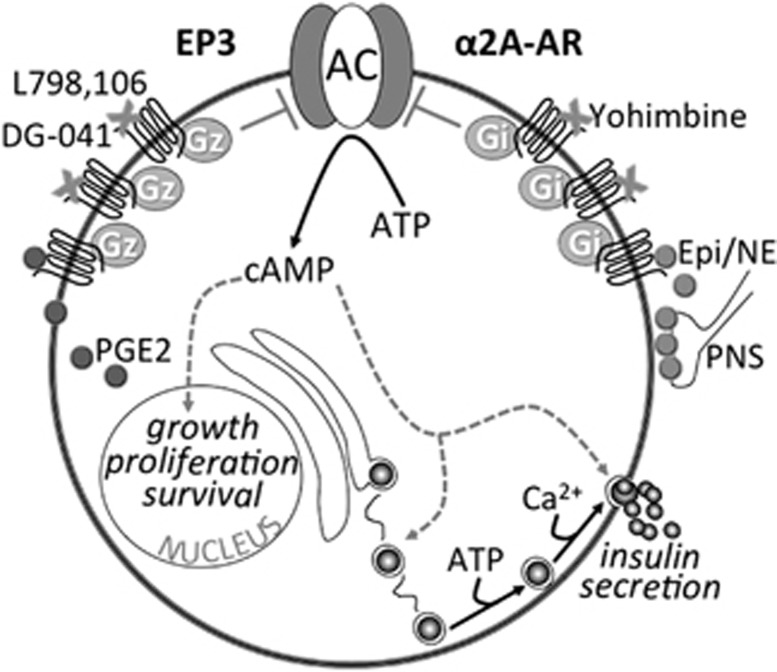Figure 1.
Summary of some of the proposed mechanisms of dysfunctional E prostanoid receptor 3 (EP3) and α2A-adrenergic receptor (α2A-AR) signaling in diabetic beta cells and how these receptors might be targeted in type 2 diabetes mellitus (T2DM) therapy. In a schematic of a diabetic beta cell, both expression and/or activity of both EP3 (left) and α2A-AR (right) have been shown to be dysfunctionally upregulated. Increased EP3 expression/activity is exacerbated by increased prostaglandin E2 (PGE2) production, acting in an autocrine/paracrine manner to further reduce cyclic AMP (cAMP) production by Gi subfamily member, Gz, signaling to adenylate cyclase (AC). In contrast, the release of α2A-AR agonists epinephrine and norepinephrine (Epi/NE) after stimulation by the parasympathetic nervous system (PNS) is not necessarily dysfunctionally upregulated in T2DM; rather, a specific ADRA2A single nucleotide polymorphism (SNP) confers increased stability of α2A-AR at the plasma membrane, allowing Epi/NE to tonically signal through α2A-AR and associated Gi subfamily proteins to reduce cAMP production by AC. Of note, cAMP is one of the only signaling pathways shown to positively impact on both beta cell mass (that is, growth, proliferation and survival) and beta cell function (that is, insulin secretion). Gray arrows and text indicate confirmed or potential downregulation of these effects with dysfunctional EP3 or α2A-AR signaling. The EP3 antagonist, L798,106, has been shown to reverse diabetic beta cell dysfunction in isolated islets in vitro, while DG-041 has gone through clinical trials for a different indication, indicating potential in vivo utility. Also suggested in this figure is the potential to target EP3 signaling by reducing PGE2 production with nutritional or pharmacological interventions. With regards to α2A-AR, a specific antagonist, yohimbine, improves insulin secretion from islets isolated from individuals with the specific ADRA2A SNP conferring α2A-AR stability. A clinical trial to confirm this finding in vivo has been initiated. Again, both EP3 and α2A-AR antagonists have the potential to improve beta cell mass, but this has yet to be confirmed.

